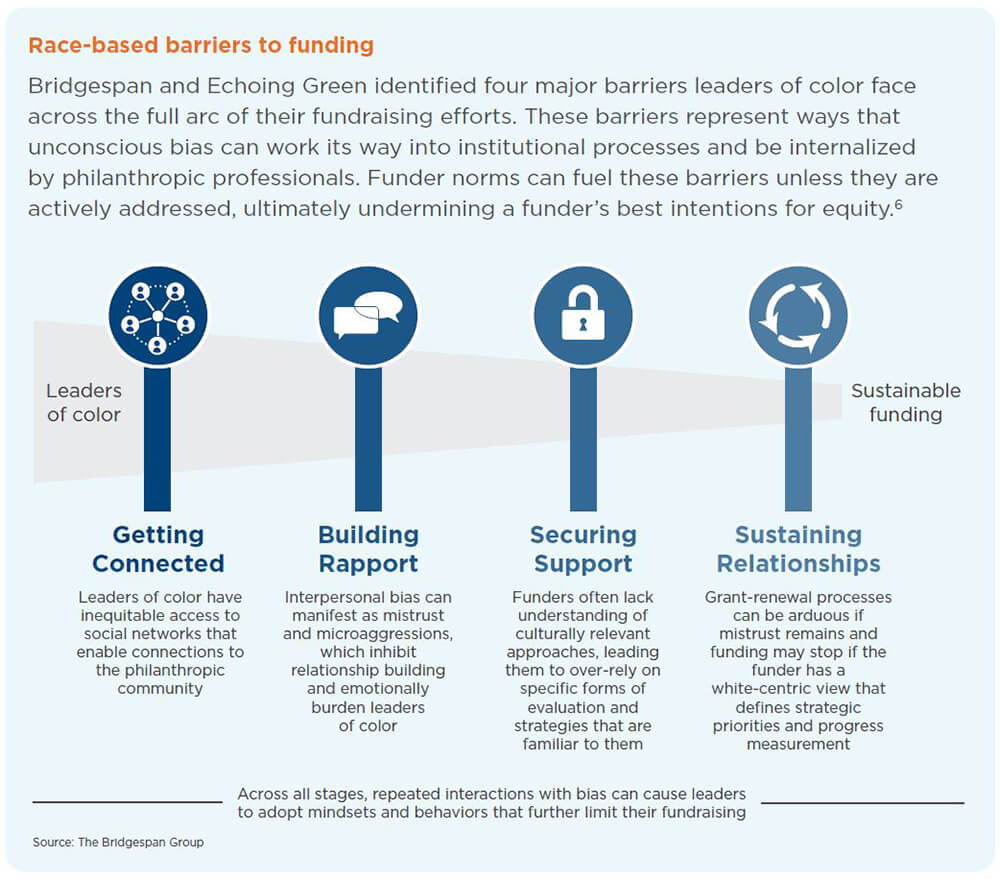Overview: The 1954 Project Approach to Equitable Philanthropy
Investing in Black leaders and organizations is a powerful opportunity for impact. Over and over again, such leaders have been able to achieve significant results with a fraction of the resources of their white counterparts. Case in point: The 1954 Project is radically redesigning how philanthropy connects with Black leaders in education, not only by upending chronic underinvestment, but also by reinventing how investments are made.
This case study provides an overview of the ways The 1954 Project has invested in Black leaders as it explores how philanthropy can evolve to overcome race-based barriers to capital (see below). The 1954 Project is early on its path, yet other funders can learn from its work to better understand what the work of equitable philanthropy entails. 1
Finalist Verneé Green, CEO of Mikva Challenge, which uses civic engagement programs to develop young people nationwide to be empowered, informed, and active citizens who promote a just and equitable society, talks about the network she built through The 1954 Project.
The urgency to invest in Black leadership
 Despite their impact, Black-led organizations face significant race-based barriers to funding, whether from philanthropy, federal funding, or corporate funding. Research conducted by Echoing Green and The Bridgespan Group found that among organizations of a similar stage and caliber, the average revenues of Black-led organizations were 24 percent smaller than their white-led counterparts, and the unrestricted assets of Black-led organizations were 76 percent smaller. Furthermore, organizations led by Black women received less money than those run by white women and Black men—underscoring the intersecting barriers along lines of race and gender.
Despite their impact, Black-led organizations face significant race-based barriers to funding, whether from philanthropy, federal funding, or corporate funding. Research conducted by Echoing Green and The Bridgespan Group found that among organizations of a similar stage and caliber, the average revenues of Black-led organizations were 24 percent smaller than their white-led counterparts, and the unrestricted assets of Black-led organizations were 76 percent smaller. Furthermore, organizations led by Black women received less money than those run by white women and Black men—underscoring the intersecting barriers along lines of race and gender.
Among organizations in Echoing Green’s Black Male Achievement Fellowship, which focuses on improving the life outcomes of Black men and boys in the United States, the revenues of the Black-led organizations were 45 percent smaller than those of the white-led organizations, and the unrestricted net assets of the Black-led organizations were a whopping 91 percent smaller than the white-led organizations—despite focusing on the same work. This pattern extends to the largest organizations working on racial equity—more than a third of the top 20 racial equity grant recipients are organizations that were launched and driven by white business leaders.
While some donors stepped up their funding to Black-led organizations in recent years, these “crisis donations” have not been enough to address the compounding disparity of historical underinvestment. Black-led organizations not only are disproportionally underfunded, but the funding they do secure is often shorter-term and less flexible. Endowments and other long-term capital commitments to assets are a common way of making large gifts to institutional nonprofits. As of 2018, endowments to high-profile Black-led social change organizations such as the NAACP, the Equal Justice Initiative, and Community Change amounted to zero.
Finalist David Merritt, founder and president of Give Merit, which works to prevent young people in Detroit from dropping out of high school, shares thoughts on his 1954 Project experience.
There are deeply harmful consequences of inadequate funding for Black leaders and organizations. In general, these organizations are forced to dedicate more of their time to fundraising, rather than to directly advancing their strategies. Understaffing can contribute to burnout. Lack of unrestricted funding and lack of sufficient general operating support starve the core infrastructure and functions of an organization (HR, finance, executive leadership, etc.). In addition, inadequate funding makes it much harder for leaders to take risks, “fail” productively, and learn, which can stall innovation.
Lastly, even though The 1954 Project’s experience is specifically with Black-led organizations, make no mistake, there are lessons here for the investment in all leaders of color. Although Black-led organizations continue to succeed despite chronic underfunding, these organizations may never reach their full potential unless they have the support and financial security to dream.
Unfortunately, race-based barriers to funding and chronic underinvestment are widely shared experiences. We point this out because a world where organizations led by people of color cannot afford to dream is a world where equity and justice fail to flourish.
The authors thank Bridgespan colleague Cora Daniels for her editorial support and The 1954 Project Luminaries and Finalists interviewed for being so generous with their time.





